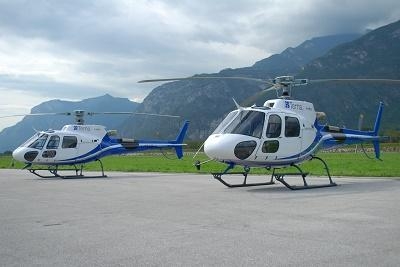Found Pilot Made Several Landing Attempts Before Losing Control Of The Aircraft
The NTSB has released a preliminary report from an accident which occurred on November 18, 2015, about 1624 Pacific standard time. An Airbus Helicopters AS350B3E, N711BE, departed controlled flight while landing on a moveable helipad at Mc Clellan-Palomar Airport, Carlsbad, California. The pilot was the owner of the aircraft. He and a private pilot-rated passenger were fatally injured; the helicopter sustained substantial damage. The local personal flight departed Carlsbad at 1411. Visual meteorological conditions prevailed, and no flight plan had been filed.

The entire accident sequence was captured on airport security cameras and the mobile phone cameras of multiple witnesses.
The helicopter departed earlier in the day from the east end of the Premier Jet FBO ramp, which was located midfield on the south side of runway 6/24. After departure, line crew moved the helipad to the west end of the ramp.
Upon returning, the helicopter approached the airport from the northeast and was cleared to land on runway 24. It descended to midfield, turned left, and approached the ramp in a low hover via taxiway A3. The helicopter then followed taxiway A and began an approach to the helipad from the east and into the direction of the sun. The helicopter then landed short of the helipad, with the center of its skids making contact with the pad's front edge. The helicopter immediately rocked back and its tailskid struck the ground. The helicopter then began a series of back and forth oscillations, and the helipad broke free from the rear left chock, rotated to the right, and pivoted around its front right wheel. The helicopter spun with the helipad for the first quarter of the turn, and then rapidly climbed and rotated 270 degrees to the right. The helipad came to rest to the north, having revolved 180 degrees, and about 50 seconds later the helicopter landed on the tarmac east of the helipad, while partially
straddling taxiway A and the ramp at a 45-degree angle.
For the next 2 1/2 minutes line crew re-secured the helipad, installing chocks on three of the four wheels. The helicopter then repositioned for an approach to the helipad from the west. During the next 4 1/2 minutes the helicopter made three landing attempts, getting to within 5 to 20 ft of the helipad. A video of the final landing attempt was captured by a witness, who was located about 130 ft south. He had observed the other landing attempts and was concerned that the helicopter may crash, so positioned himself behind a car at the corner of the FBO's hangar.
The video revealed that the helicopter again landed short of the pad, similar to the first landing attempt, rocking back and forth twice onto its tailskid. After the final strike, the helicopter pitched violently forward and out of view behind the hangar. Security cameras revealed that from here the helicopter spun 180 degrees to the left, and after reaching a 45-degree nose up attitude, the aft tailrotor and vertical stabilizer assembly struck the ground and separated. The helicopter bounced and rotated another 360 degrees before landing hard on its left side. Once on the ground, the main rotor blades and cabin continued to spin with the engine still running. The helicopter continued spinning for the next 5 minutes and 10 seconds while slowly sliding about 530 ft east along the ramp. The tailboom and horizontal stabilizer then separated and the helicopter rolled onto its side, shedding the main rotor blades. The engine continued operating for another 30 seconds while fire crew doused the helicopter.
White smoke billowed from the engine's exhaust after the helicopter came to rest, but there was no indication of fire.
The pilot purchased the helicopter on October 29, 2015, but had flown demonstration and familiarization flights in it since September 20. According to the helicopter's maintenance records, those flights totaled about 8.8 hours, and were all conducted with a certified flight instructor present. He received an additional 2 hours of flight training on November 13.
According to friends and flight instructors who had flown with the pilot, he had previously owned a Bell 407, and the accident flight was the first he had flown in the AS350 series without a professional pilot present.
(Source: NTSB preliminary report. Image from file)
 ANN's Daily Aero-Term (04.24.24): Runway Lead-in Light System
ANN's Daily Aero-Term (04.24.24): Runway Lead-in Light System ANN's Daily Aero-Linx (04.24.24)
ANN's Daily Aero-Linx (04.24.24) Aero-FAQ: Dave Juwel's Aviation Marketing Stories -- ITBOA BNITBOB
Aero-FAQ: Dave Juwel's Aviation Marketing Stories -- ITBOA BNITBOB Classic Aero-TV: Best Seat in The House -- 'Inside' The AeroShell Aerobatic Team
Classic Aero-TV: Best Seat in The House -- 'Inside' The AeroShell Aerobatic Team Airborne Affordable Flyers 04.18.24: CarbonCub UL, Fisher, Affordable Flyer Expo
Airborne Affordable Flyers 04.18.24: CarbonCub UL, Fisher, Affordable Flyer Expo



